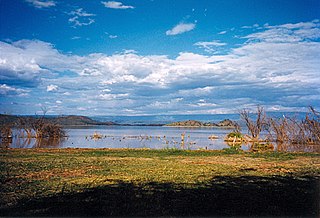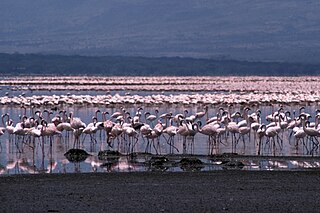
The Great Rift Valley is a series of contiguous geographic trenches, approximately 7,000 kilometres (4,300 mi) in total length, that runs from Lebanon in Asia to Mozambique in Southeast Africa. While the name continues in some usages, it is rarely used in geology as it is considered an imprecise merging of separate though related rift and fault systems.

Lake Baringo is, after Lake Turkana, the most northern of the Kenyan Rift Valley lakes, with a surface area of 130 square kilometres (50 sq mi) and an elevation of 970 metres (3,180 ft). The lake is fed by several rivers: the Molo, Perkerra and Ol Arabel. It has no obvious outlet; the waters are assumed to seep through lake sediments into the faulted volcanic bedrock. It is one of the two freshwater lakes in the Rift Valley in Kenya, the other being Lake Naivasha.

Rift Valley Province of Kenya, bordering Uganda, was one of Kenya's eight provinces, before the Kenyan general election, 2013. Rift Valley Province was the largest and one of the most economically important provinces in Kenya. It was dominated by the Kenya Rift Valley which passes through it and gives the province its name. According to the 2009 Census, the former province covered an area of 182,505.1 square kilometres and would have had a population of 10,006,805, making it the largest and most populous province in the country. The bulk of the provincial population inhabited a strip between former Nairobi and Nyanza Province. The capital was the town of Nakuru.

Nakuru County is a county in Kenya. It is County number 32 out of the 47 Kenyan Counties. The capital and largest town is Nakuru, with Naivasha being another major significant urban centre. With a population of 2,162,202, it is the third most populous county in Kenya after Nairobi County and Kiambu County, in that order. With an area of 7,496.5 km², it is Kenya's 19th largest county in size. Until August 21, 2010, it formed part of Rift Valley Province.

Lake Nakuru is one of the Rift Valley lakes at an elevation of 1,754 m (5,755 ft) above sea level. It lies to the south of Nakuru, in the rift valley of Kenya and is protected by Lake Nakuru National Park.
The Soysambu Conservancy was created in 2007 as an entity to conserve the flora, fauna and scenery of Soysambu Ranch, which is to the northwest of Gilgil, Rift Valley Province, Kenya. The Conservancy has taken a conservation lease over the ranch, which would be the portal to the proposed Nakuru-Naivasha wildlife corridor. The Conservancy is 48,000 acres (190 km2) and borders the Elmenteita Badlands in the south in the area around Mawe Mbili. On the west it shares a boundary of 12.1 km with Lake Nakuru National Park.

The Great Rift Valley is part of an intra-continental ridge system that runs through Kenya from north to south. It is part of the Gregory Rift, the eastern branch of the East African Rift, which starts in Tanzania to the south and continues northward into Ethiopia. It was formed on the "Kenyan Dome" a geographical upwelling created by the interactions of three major tectonics: the Arabian, Nubian, and Somalian plates. In the past, it was seen as part of a "Great Rift Valley" that ran from Madagascar to Syria. Most of the valley falls within the former Rift Valley Province.
The Gilgil River drains part of the floor of the Great Rift Valley, Kenya and the plateau to the east of the valley, flowing from the north into Lake Naivasha. The river runs to the east of the town of Gilgil, which is on the height of land between the Lake Naivasha and Lake Elmenteita basins.
Streptomyces aidingensis is a Gram-positive, aerobic bacterium species from the genus of Streptomyces, which has been isolated from sediments of the Aiding Lake in Tulufan Basin in north-west China.
Streptomyces smyrnaeus is a halotolerant bacterium species from the genus of Streptomyces which has been isolated from pond sediments from a salt lake in Izmir in Turkey.

The Elmenteitan culture was a prehistoric lithic industry and pottery tradition with a distinct pattern of land use, hunting and pastoralism that appeared and developed on the western plains of Kenya, East Africa during the Pastoral Neolithic c.3300-1200 BP. It was named by archaeologist Louis Leakey after Lake Elmenteita, a soda lake located in the Great Rift Valley, about 120 km (75 mi) northwest of Nairobi.
Belliella kenyensis is a Gram-negative and aerobic bacterium from the genus of Belliella which has been isolated from lake sediments from the alkaline Lake Elmenteita from the Kenyan Rift Valley in Kenya.
Dethiobacter alkaliphilus is a bacterium from the genus of Dethiobacter which has been isolated from sediments from a soda lake in the Mongolia.
Streptomyces chitinivorans is a chitinolytic bacterium species from the genus of Streptomyces which has been isolated from lake sediments from a fish dumping yard in Balugaon in India.
Nitriliruptor alkaliphilus is a non-spore-forming and non-motile bacterium from the genus Nitriliruptor which has been isolated from sediments from a soda lake in Siberia in Russia.
Halolactibacillus alkaliphilus is a Gram-positive, facultative anaerobic, moderately alkaliphilic, halophilic and non-motile bacterium from the genus of Halolactibacillus which has been isolated from sediments from the Xiarinaoer soda lake from the Mongolia.
Salisediminibacterium halotolerans is a gram-positive, alkalitolerant, and halophilic bacterium from the family Bacillaceae and genus of Salisediminibacterium, which was one of three bacterial strains, and the only novel species, isolated from sediments from the Xiarinaoer soda lake in Mongolia in 2012.
Chitinivibrio is an extremely haloalkaliphilic genus of bacteria from the family of Chitinivibrionaceae with one known species. Chitinivibrio alkaliphilus has been isolated from hypersaline lake sediments from Wadi al Natrun in Egypt.
Streptomyces alkaliterrae is a bacterium species from the genus Streptomyces which has been isolated from alkaline soil.
Streptomyces sediminis is a bacterium species from the genus of Streptomyces which has been isolated from sediments of a crater lake from Anatolia in Turkey.






